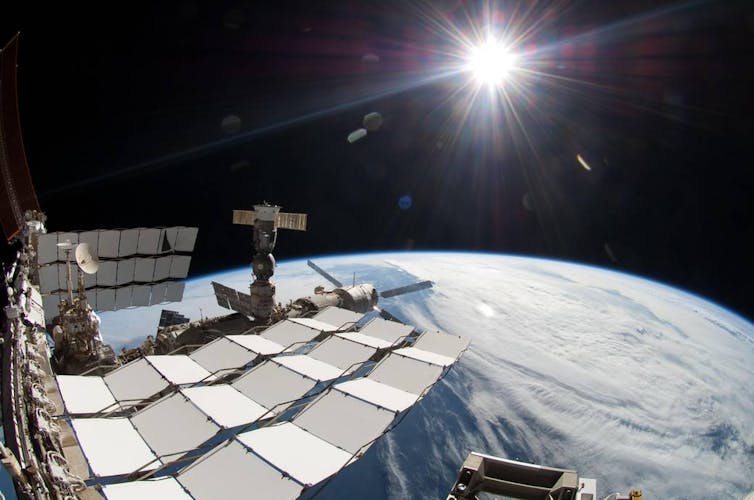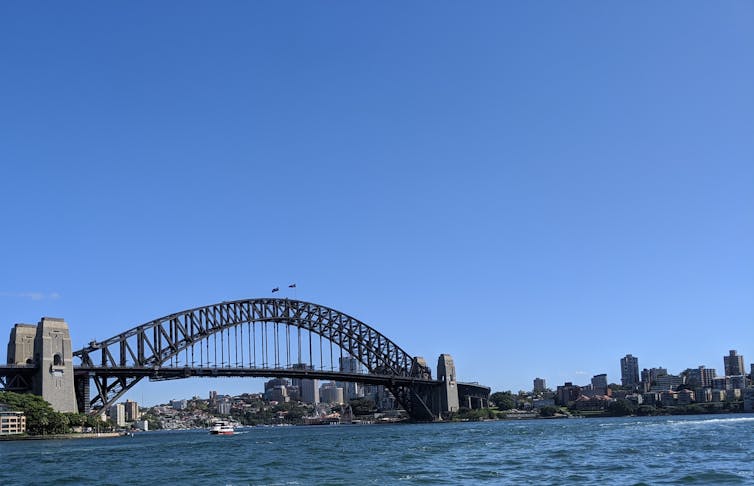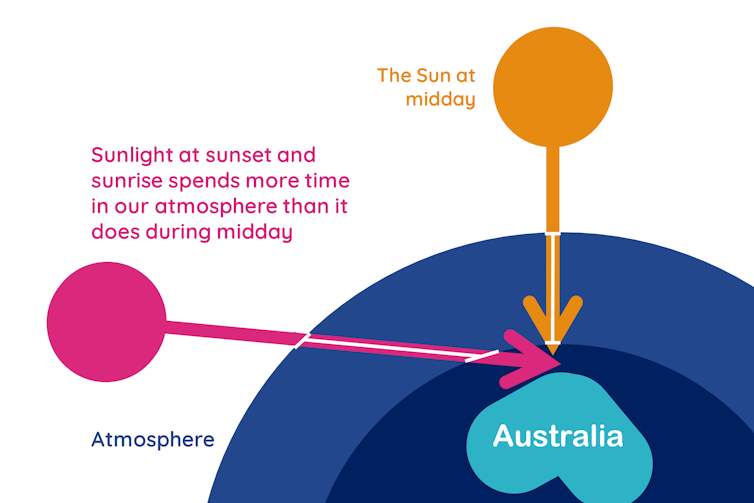how does the Sun make such pretty colours at sunsets and sunrises?
- Written by Jake Clark, PhD Candidate, University of Southern Queensland
How does the Sun make such pretty colours at sunsets and sunrises? — Aisling, age 7, Mount Gambier, South Australia
Hi Aisling. Thank you for this super interesting question!
We love watching all the pretty colours of sunsets and sunrises. But why does this happen, when most of the time the sky is just blue?
Well, it’s all because of light and the fact that light has colour. Believe it or not, the light around you is a combination of all the colours in the world.
But if this is true, why do we only see some colours in the sky at certain times, and not all of them?
To know this, we first need to know how day turns into night.
 In Australia, we get beautiful views of the sun setting on most days — as long as we have a good spot to watch from. The sky lights up with bright reds and oranges.
Jake Clark
In Australia, we get beautiful views of the sun setting on most days — as long as we have a good spot to watch from. The sky lights up with bright reds and oranges.
Jake Clark
Earth goes dancing through space
Our planet, Earth, moves in space with seven other planets nearby. They all spin in circles on the spot, but also move in much larger circles around the Sun.
When the Sun is setting in Australia, this means our side of the planet is turning away from the Sun. During sunrise, we’re turning towards it.
Night time happens when we’re no longer facing the Sun at all. Daytime happens when we have twirled to face the Sun directly — so its sunbeams travel (very fast) directly to us.
Although you can’t tell by looking at them, beams of light from the Sun come in different sizes. Scientists measure these sizes using something called “wavelength”.
Each different wavelength of light has its own unique colour.
Earth is wrapped in its atmosphere
So we know why the sky is bright during the day and dark at night. And we know sunbeams come in different sizes, or “wavelengths”.
But how does it become the gorgeous colours we see during sunset and sunrise?
This happens because of an important blanket of air wrapped around Earth, called the atmosphere.
Earth’s atmosphere is made up of many very tiny objects called molecules. In fact, all things are made of molecules, including you and me.
But each molecule is much, much smaller than a grain of sand. They’re so small you can’t see them without a microscope — you can only see the bigger things they make.
 If you were an astronaut onboard the International Space Station, you’d have crossed Earth’s atmosphere to get there.
NASA
If you were an astronaut onboard the International Space Station, you’d have crossed Earth’s atmosphere to get there.
NASA
How the atmosphere plays with light
When the Sun’s beams reach Earth, they meet the molecules in Earth’s atmosphere. The molecules then begin to play with the light — bouncing it back and forth between themselves. This is called “scattering”.
The longer a wavelength of light is, the longer it can keep scattering between the molecules in our Earth’s atmosphere before “tiring out” and going back into space.
Blue light has a shorter wavelength than red or pink light. This means it can only bounce between the molecules for a shorter distance.
When Australia is directly facing the Sun (daytime), there’s less atmosphere for the light to pass through. Blue light can easily come out the other side — giving us a blue sky.
 Although the sky and ocean are both blue, the reasons for why they’re blue are different.
Jake Clark
Although the sky and ocean are both blue, the reasons for why they’re blue are different.
Jake Clark
The colours of sunrise and sunset
We already know Earth spins in its place. Remember that during sunset in Australia, we are circling away from the Sun and no longer facing it directly.
This means sunlight has to travel through a thicker slice of the atmosphere to reach us. This happens during sunrise too, when Australia is moving towards the Sun.
 Here we can see how, to reach Australia, light has to travel through Earth’s atmosphere for a longer distance during sunrise and sunset, when we’re not directly facing the Sun.
Author provided
Here we can see how, to reach Australia, light has to travel through Earth’s atmosphere for a longer distance during sunrise and sunset, when we’re not directly facing the Sun.
Author provided
With this larger distance of atmosphere to cover, the blue light gets tired. It can’t keep up anymore, so it mostly bounces back out into space.
But the red, orange and yellow light have longer wavelengths. This means they can scatter for longer and travel through the atmosphere to reach us.
And this is why we have beautiful bright sunsets and sunrises.
Authors: Jake Clark, PhD Candidate, University of Southern Queensland






